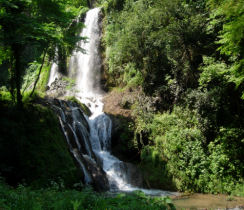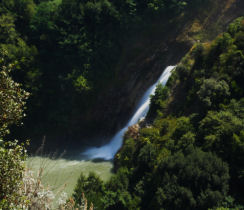The Grand Tour and Villa Gregoriana
"Villa Gregoriana" Park is located on the left side of the great fall of the Aniene river, in the so-called "Baratri Tiburtini" (precipices of Tivoli) just underneath the acropolis of Tivoli, overlooked by the famous temples of Vesta and of the Sybil. These, even if just outside the perimeter of the Villa, can be considered, without any doubt, among the archaeological patrimony of the Park. The importance of the place, dating back to the ancient times, is testified by several literary citations among which, the lines from the Horace's "Odes" and the verses of the Statius' "Sylvae" describing Manlio Vopisco's roman villa, which remains are inside "Villa Gregoriana" Park. Many pictorial representations of the Acropolis' cliff, with the temples and the Aniene's waterfall testify to the importance of the place that never decreased, reaching its height between the eighteenth and the nineteenth century. In this period, in fact, the place became a privileged and obliged destination of many Grand Tour travellers. In 1706, Addison noted that "painters often came to Tivoli from Rome to study the Tivoli landscape".
We can't forget, in fact, that the landscapists Claude Lorrain and Poussin studied it drawing inspiration for their works. The poet Thomas Gray was impressed by the power of the great fall. Likewise, we can't fail to mention Honoré Fragonard (1732 - 1806), who having won the annual competition "Prix de Rome" in 1752, stayed in "Villa d'Este" (Tivoli) for three months, as a guest of the Abbot Richard de Saint-Non, studying the magnificent landscape. In 1760 he made wonderful drawings while in Tivoli, among which, "the Temple of Sybil", a sanguine on light traces of black pencil. Still we would like to mention another famous visitor and artist: John "Warwich" Smith (1749 - 1831) one of the most admired watercolorist of the time, of which we remember "The Mecenate's Villa of Tivoli" painted around 1776-81. Also Louis Ducros (1748-1810) and many others.
The "Temple of Vesta in Tivoli" carved in cork is one of the souvenirs of Tivoli, (it was made by an anonymous artist in 1770), as well as some painted fans, etc.. But, let's go back to other travellers who came here being attracted by so much beauty. Among them, we have to remember Wolfang Goethe (1749 - 1832) who between 1786 and 1788 travelled in Italy under a false name and many years later, his travel was documented in a diary "Viaggio in Italia" (Journey to Italy) (1828). Remembering the view of the Tivoli Falls he wrote ".during these days I was in Tivoli and I saw one of the first shows of nature. The Falls, with the remains and the whole landscape belong to those things, the knowledge of which makes us richer deep inside ourselves". Neither we can fail to remember Chateaubriand, Madame de Stael, George Sand, just to mention a few of the very famous people that came here.
As evidence of the presence of all these travellers and by the will of the Governor of Rome, in 1809 there were the first public works to make the place accessible to the travellers of the Grand Tour. Already in this period nature was starting to take shape according to the neo-classical taste, with the creation of footpaths and clearings to allow visitors to stop and enjoy the view and, in order to allow them to visit the Neptune Cave, a tunnel was bored through the rock, with openings that provided picturesque views of the precipices underneath. Still today, dozens of memorial plaques, covered by lichens, remind us of emperors and empresses, kings and queens, ruling sovereigns or deprived of their powers, who found, in the beauty of the Park, the magic of the Italian landscape joined with the impressing valour of centuries of history.
Surroundings
-
The Sacro Speco

An impressive complex of buildings which almost looks as if it is one with the surrounding rock...
To know more
-
Rocca Pia
Built on the place where Callisto II Borgia's Castle was situated...
-
Church of St.Peter
It was built on the rests of a roman villa...
Tivoli's attractions

Patrocinio Comune di Tivoli
Assessorato al Turismo




